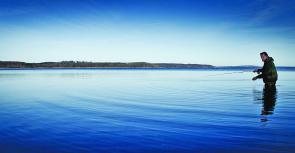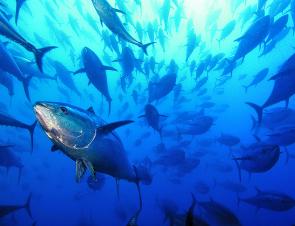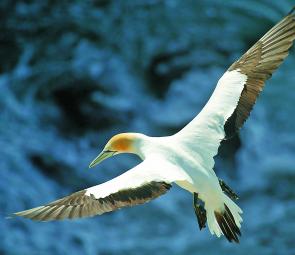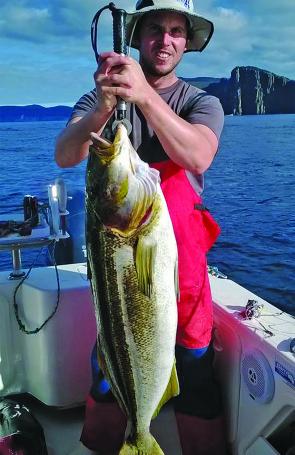Okay, okay, we can’t avoid it any longer – we are in the thick of winter and a lot of the fishing has slowed down. But hey, let’s not despair as often it can just be our attitude to the cold that slows us down. There are still some really good options for the angler in us all.
Trout waters have closed and for good reason. The pressure is off these fish as they can enjoy some good old-fashioned spawning rumpy pumpy. There are a number of waters that remain open all year round so check with the fisheries website and tackle stores for the good oil on these.
Snow on the mountains will mean a good set of thermal undies and some quality neoprene waders for the hardy. It’s a given the highlands are going to be a real test for all but the super keen, but don’t forget the coastal river systems. The Inland Fisheries website will have all the info on where you can start and stop to target trout in your favourite waterway.
You are looking for an early sea run or resident brown trout in these waters with all your usual methods. Spinning from the shore is very productive at dusk and in overcast conditions.
July again is cold, but often filled with clear calm days so don’t pack the fly rod away altogether. Given the lack of insect activity you will find yourself doing a fair bit of blind casting or using wet flies. Sight fishing is of course an option until a big rain ruins the visibility.
In the lower reaches and estuaries you will encounter a lot more than just trout while swishing away. It can be a great time for the beginner to practice all aspects of flycasting. Mullet, bream and Australian salmon can keep you amused until you find your next trout to fool.
The tail end of May and June had Eagle Hawk neck firing. The school sized fish were anywhere you cared to mention and if you found them when they came on to feed you were bound to have success. July will be no exception with the added hope the big jumbos have thickened up with the cooler weather.
We are exceptionally spoilt in regard to the distance we can travel to find fish in Tasmania. You will drive over a lot of fish if you think you have to beeline to the Hippolyte Rocks and Tasman Island to get fish. Areas just outside Pirates Bay have been holding good bait and in turn good numbers of southern bluefin tuna.
When the fish are on, all lures will work well and it is important to get the trolling speed right for the sea conditions. Keep a good eye on the spread while traveling into the conditions and get the skirts to pull a smoke trail and look active. This speed will differ when you are travelling down sea and with the wind. Throttling the engine speed back accordingly will make a huge difference. This allows for the boat and lures to speed up and settle a touch in the wave trough.
Zacatak’s range of skirts are a great starting point. Hand made in Australia and of a quality that will sit down in the waves and swell when the traditional Tassie seas are a bit angry. Sub surface lures are a great option and you just can’t go past a Halco Max, or for a deeper presentation Halco’s range of Laser Pros.
The fish will be about this time of year, it is just a matter of where? The trick is finding the bait, sounding the tuna and working the area over. Should you get a fish strike, nail a waypoint down straight away; when you have boated the fish get back over the area again quickly. No need to get your full 4 or 5 rod spread back out again, running perfect. Once you are back over the area, have the lure out and be circling the area and tracking back over the waypoint as you get the other lures back in the water.
The species of bird, how they are reacting and height in the sky will give you a really good indication of what is going on underneath them. When fishing with a good crew one person needs to be designated bird spotter and take the role seriously.
On a slow day when the fish are hard to come across, the feathered brigade are your best friend – none more so than the Australian gannet. If you spot three or four of them gaining height off into the distance, this is excuse enough to give them better attention. As soon as they start to stall in the air and try and maintain position you know they are very interested.
It is amazing how the other birds in the area can spot this activity and before long a ‘feed’ will start.
It may have been a quiet day and things have been slow, but now is not the time to charge in ripping and tearing. If you have been on the ball and got to a school as it is starting to form, the worst thing you can do is motor straight over the top of them.
Ideally work out which way you are going to roll around them and aim to drag your spread down one side and as you turn fairly hard around them you will pull your longer lures right through the middle of it and have them exit out the other side.
July can have some bright, clear still days and watching the weather forecast can pay dividends.
Striped trumpeter and blue eye trevalla will be out on their usual haunts waiting for you to get a bait in front of them.
Those of you still using Alvey reels or big egg beaters to haul these tasty fish will welcome the cooler conditions. Winding up a 4 hook rig fully loaded with fish from 400m is hard work.
Good weather and sea conditions and some movement either side of the tide change will have you in good stead to find some of the world’s best eating fish. Fresh bait and some perseverance and there is no telling what you will pull up!
The big news in Tasmania is Leo Millar and his crew. Leo is a local angler that has been putting in some serious time and effort into cracking the broadbill code in our waters. He and his crew have found fish consistently and have boated two, narrowly missing Tasmania and Australian game fishing records due to slight regulation issues.
New fisheries and new techniques are a great way to excite anglers and Leo’s enthusiasm is infectious. A number of keen anglers are following and trying to replicate Leo and his gang of super keen fishos. This is one type of fishing that needs considerable technique and planning. Very exciting stuff indeed.
So rug up, get into a tackle store for the good oil and get out in some of the most spectacular marine environments in the world.
Reads: 2326
Cool and calm conditions to hone the craft.

Pirates Bay have been holding good bait and in turn good numbers of southern bluefin tuna.

On a slow day when the fish are hard to come across, the feathered brigade are your best friend.

From the reef to the teeth.

Leo Millar and his crew have been putting in some serious time and effort into cracking the broadbill code in local waters.




